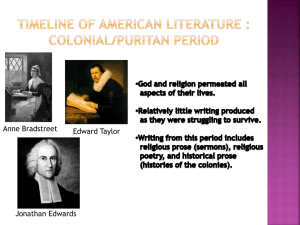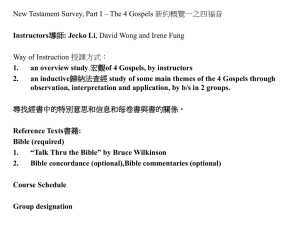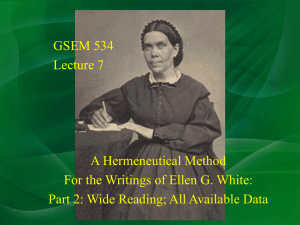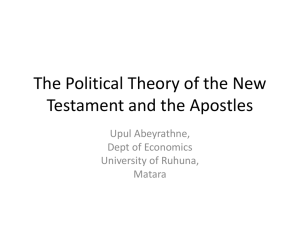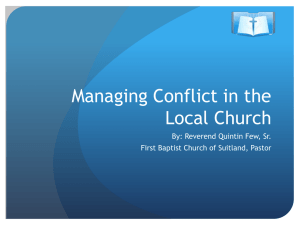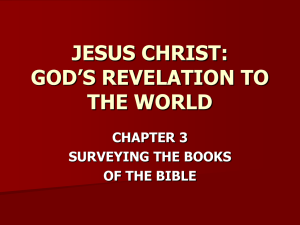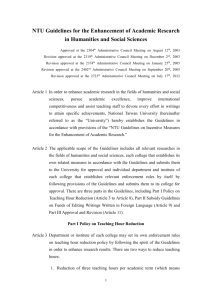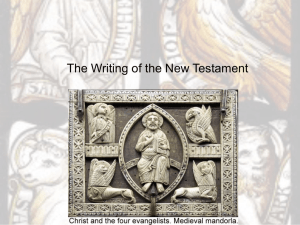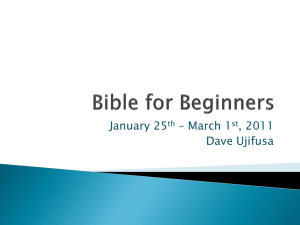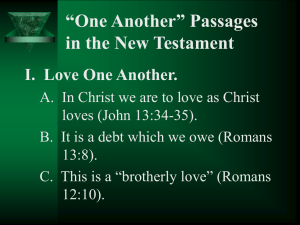Canonicity of New Testament
advertisement
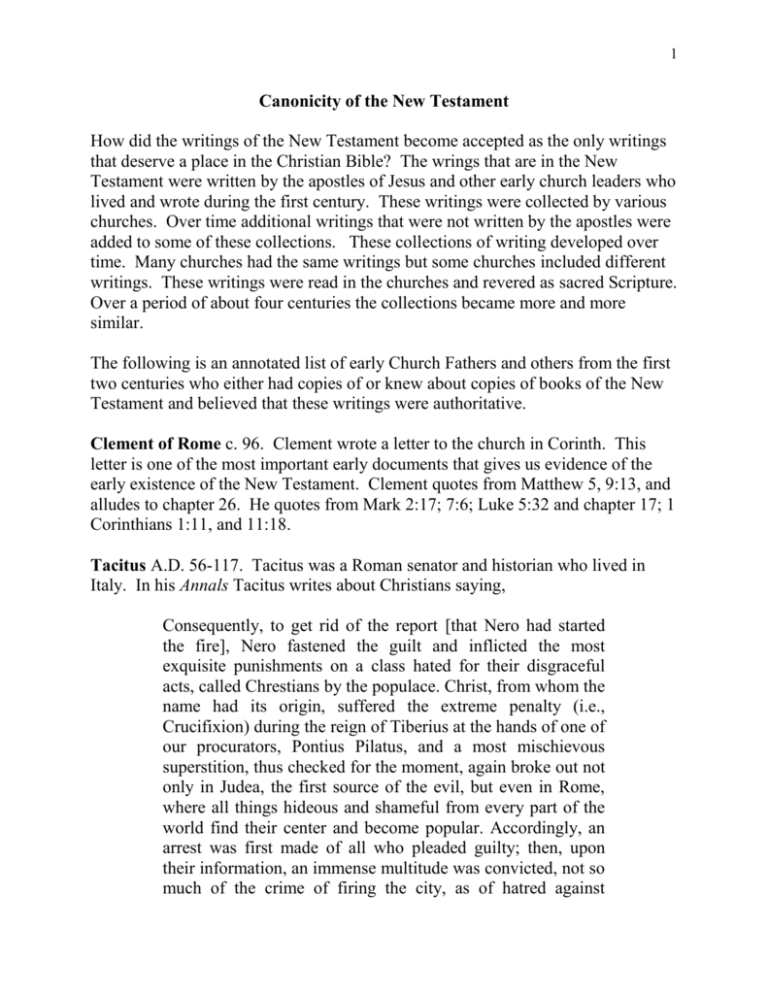
1 Canonicity of the New Testament How did the writings of the New Testament become accepted as the only writings that deserve a place in the Christian Bible? The wrings that are in the New Testament were written by the apostles of Jesus and other early church leaders who lived and wrote during the first century. These writings were collected by various churches. Over time additional writings that were not written by the apostles were added to some of these collections. These collections of writing developed over time. Many churches had the same writings but some churches included different writings. These writings were read in the churches and revered as sacred Scripture. Over a period of about four centuries the collections became more and more similar. The following is an annotated list of early Church Fathers and others from the first two centuries who either had copies of or knew about copies of books of the New Testament and believed that these writings were authoritative. Clement of Rome c. 96. Clement wrote a letter to the church in Corinth. This letter is one of the most important early documents that gives us evidence of the early existence of the New Testament. Clement quotes from Matthew 5, 9:13, and alludes to chapter 26. He quotes from Mark 2:17; 7:6; Luke 5:32 and chapter 17; 1 Corinthians 1:11, and 11:18. Tacitus A.D. 56-117. Tacitus was a Roman senator and historian who lived in Italy. In his Annals Tacitus writes about Christians saying, Consequently, to get rid of the report [that Nero had started the fire], Nero fastened the guilt and inflicted the most exquisite punishments on a class hated for their disgraceful acts, called Chrestians by the populace. Christ, from whom the name had its origin, suffered the extreme penalty (i.e., Crucifixion) during the reign of Tiberius at the hands of one of our procurators, Pontius Pilatus, and a most mischievous superstition, thus checked for the moment, again broke out not only in Judea, the first source of the evil, but even in Rome, where all things hideous and shameful from every part of the world find their center and become popular. Accordingly, an arrest was first made of all who pleaded guilty; then, upon their information, an immense multitude was convicted, not so much of the crime of firing the city, as of hatred against 2 mankind. Mockery of every sort was added to their deaths. Covered with the skins of beasts, they were torn by dogs and perished, or were nailed to crosses, or were doomed to the flames and burnt, to serve as a nightly illumination, when daylight had expired. Pliny the Younger A.D. 61-112. Pliny the Younger lived in Italy and served as an imperial lawyer. Pliny wrote to Emperor Trajan asking him for advice on how to deal with the Christians. Pliny was worried because he feared that the Christians, who were growing in great numbers, may have had political motives. Through interrogation and torture Pliny learned that the Christians were only meeting for prayer and worship of Christ. Didache (Egypt) c. 100. The Didache was an important document of church practice for the early church. Quotes from Matthew 6:9-13 and 28:19. Ignatius, bishop of Antioch c. 110. Ignatius has many loose quotations and allusions to writings of the New Testament. Polycarp, bishop of Smyrna c. 115. Polycarp was a disciple of the apostle John. Polycarp has allusions to John 5:29; 6:54; Ephesians 4:26; Philippians 2:16; and 2 Timothy 4:10 Papias, bishop of Hierapolis, Phrygia c. 125. Papias may have known the Apostle John. He was acquainted with Polycarp and learned about Jesus from Polycarp and other men who had been disciples of Jesus’ apostles. Papias believed that Mark received his gospel from Peter. He knew also of Matthew’s Gospel. Letter of Pseudo-Barnabas (Syria) c. 70-130. References to Matthew 22:14; 26:31. Letter of Pseudo-Clement c. 150 perhaps as early as 100. References to Matthew 9:13; 10:32 Lucian of Samosata c. A.D 125-180. Lucian was from Syria and traveled to Greece and Italy. Lucian in his Death of Peregrine writes: “The Christians, you know, worship a man to this day,--the distinguished personage who introduced their novel rites, and was crucified on that account.” 3 Marcion the heretic (Rome) c. 144. Marcion was born on the southern coast of Black Sea where his father was a leader in the church. Marcion accepted only the Gospel of Luke and only ten of Paul’s letters but rejected his letters to Timothy and Titus. Basilides, Gnostic leader (Alexandria) c. 130. Basilides knew about the Gospels and believed them to be a true account of Jesus’ life. He mentions John 1:9; 2:4 and quotes from Romans 8:19, 22; 1 Corinthians 2:13. Shepherd of Hermas (Rome) second century. This book was first written in Greek and was included in some early versions of the New Testament. Justin Martyr c. 165. Justin lived in Ephesus and went to Rome to be executed. Justin knew of the writings of the Apostles and the Gospels and Paul’s letters were being read in the churches. Justin alludes to John 1:1-14; 3:3-5; Hebrews 9:14-28; others Valentinus, Gnostic leader (Rome) c. 135-160. Valentinus wrote the Gospel of Truth in which he alludes to and cites as authoritative: Matthew, Luke, John, and ten letters of Paul, Hebrews, 1 John, and Revelation. Tatian’s Diatessaron c. A.D. 160-175. Written in Syria by Tatian his harmony of the four Gospels (Matthew, Mark, Luke, and John) was the standard text for Syrian speaking Christians for four centuries. Tatian was a disciple of Justin Martyr whose writings often harmonized the Gospels. Justin’s use of harmonization may be evidence for a previously existing but no-longer extant version or may have been Justin’s own invention. Heracleon, Gnostic leader (Rome) c. 170. Heracleon was a disciple of Valentinus. He wrote a commentary on John’s gospel and possibly commentaries on Matthew and Luke. His writings were read by orthodox theologians such as Origen (185254) and Clement of Alexandria (c.150 - 215). The Muratorian Fragment c. 170. The Muratorian Fragment is the oldest known list of New Testament books. Some of the document is missing but the list does include twenty writings of the twenty-seven writings that are in our New Testament. The fragment begins by stating that Luke was the third Gospel so we can assume that the document originally included the first two Gospels Matthew and Mark. The list leaves out five writings: Hebrews, James, First and Second 4 Peter and Third John. The list includes two apocryphal writings as acceptable: The Wisdom of Solomon and The Apocalypse of Peter. Conclusion: Writings of the apostles were being read by Christians in Rome, Asia Minor, and Egypt earlier than A.D. 100. Matthew wrote from Palestine, Mark, Luke, and Paul wrote from Rome. These writings were then copied and these copies were taken to various Christian centers in less than forty years. Nearly the entire New Testament can be reconstructed from the writings of the church fathers and from the writings of the heretics. These early writings substantiate the wording of the original text as authentic. No original manuscripts of the New Testament exist. Most of the modern versions of the New Testament were translated from one of three editions of the Greek New Testament. Some modern versions of the New Testament have been translated from the Majority Text also called the “Textus Receptus”. Other modern versions have been translated by mainly using the Nestle-Aland Novum Testamentum Graece. And still other modern versions of the New Testament have been translated by mainly using the Greek New Testament of the United Bible Society. These editions differ very little and almost 100% of the variances can be explained as changes in the language or scribal mistakes that are easily corrected by comparing the variances1 with other Greek manuscripts. The editors of the Greek New Testaments and the translators who use these versions have used a lengthy and thorough procedure. These translators made their editorial and interpretive decisions based on accepted principles of linguistics. No individual translator is responsible for the final version. The most reliable versions of the New Testament have been translated by teams of translators. These translators work to overcome personal biases by having their work reviewed by others on the team. As they work they are aware that thousands of Greek scholars will be reading their translations and will be able to find personal biases. In effect, the translator works with the world looking over his shoulder. variants and variances are differences in the text. The existence of almost all variants can be reasonably explained and then one can arrive at the most accurate reading. 1
